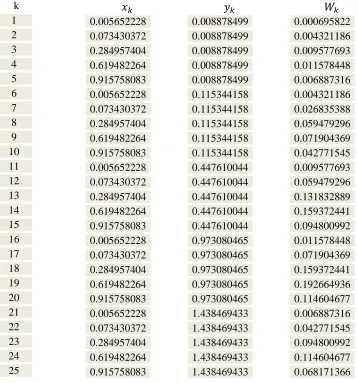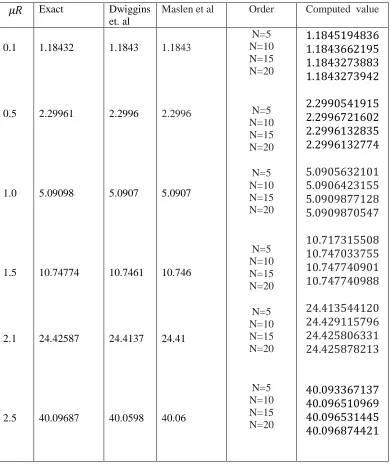Vol. 11, No. 1, 2016, 9-15
ISSN: 2279-087X (P), 2279-0888(online) Published on 1 January 2016
www.researchmathsci.org
9
Alternative Approach to Evaluation of Absorption
Correction Factor for Cylinder using Generalised
Gaussian Quadrature Rule
K.T. Shivaram1 and S.Kiran21
Department of Mathematics, Dayananda Sagar College of Engineering Bangalore, India E-mail: shivaramktshiv@gmail.com
2
Department of Mathematics, Saptageri College of Engineering Bangalore, India E-mail: kir_keerthi@yahoo.co.in
Received 11 November 2015; accepted 1 December 2015
Abstract. This paper presents Numerical evaluation of Absorption correction factor for cylinder by using Generalised Gaussian quadrature rule. The new formula increases the accuracy in comparison with the original Gauss-Legendra quadrature rules and Simpson’s method which were recently applied by Maslen(1999) and Takashi Ida(2010) et al. results obtained with the Generalised Gaussian quadrature method are compared with the existing formulae. It is shown that the Generalised Gaussian quadrature method has higher accuracy than the existing formulae.
Keywords: Finite element method, Generalised Gaussian quadrature rule, Numerical Integration.
AMS Mathematics Subject Classification (2010): 65R10
1. Introduction
The path traversed by a monochromatic beam of intensity I0 through a homogeneous
isotropic material of linear absorption coefficient µ. Then reduced intensity in the beam is given by
= (1) The path length T of the beam in the material (crystal) varies as the shape of the crystal. Therefore this equality can also be considered for the X-ray absorption for the crystalline solids whose absorption does not depend on the arrangement of the atoms in the unit cell. If the crystalline solid have a definite shape then different paths have different lengths T, then we have
= (2) Where v is the volume of the crystal the expression for the transmission coefficient is
given by = (3)
K.T.Shivaramand S.Kiran
10
through which the beam has traversed and the Braggs angle θ, the angle of orientation with respect to incident and diffracted beams, A is termed as function of µ and θ i.e. A(µ, θ) where µ is linear absorption coefficient and the reciprocal of total over all absorption coefficient is called absorption correction factor A*
In the past claasen solved the absorption coefficient A by geometrical construction for the cylindrical samples (tungsten) by graphical integration and later on as a result a table listing absorption correction factor A* where tabulated in International tables for X-ray crystallography(1959) as a function of Braggs angle θ and , where R is the radius
of the cylinder. which have a maximum error of one percent. This tabled numerical values can also be considered as absorption for single crystal circular cylinder samples provided the beam is perpendicular to the axis of the cylinder and later on Maslen (1999) tabled the numerical values of Absorption correction factor ∗, for cylinder in International tables for crystallography Vol. C (1975) by solving integral
∗, = 4
− { 1 − "#$ − %& '
+ 1 + "#$ − %& '} cosh2 "#$ "#$% %
(4) Proposed by Dwiggins (1975) using Simpsons numerical integration. Due to the existence of the singularity in the integrant at x = 1 and ∅ =
− the formula was
not favorable for the application of numerical integration. Thorkildsen and Larsen (1998a,b) proposed another formula
, =
0123 4
50126 789 :3
;<03 =
3 3
sin + % sin − % +
2 %
(5)
Takashi ida (2010) applied Gauss-Legendere quadrature formula to solve the above Eq. (5) over the range 0≤ μ ≤2.5 and 0 ≤ ≤ 90 and achieved much more accuracy in the numerical values then Simpsons method applied to Diwiggins Eq. (4)
In this paper we have applied General Gaussian Quadrature rule to calculate ∗,
the absorption correction factor using C.W. Dwiggins two-dimension integral formula Eq. (4), this method will improve the accuracy and efficiency of the finite element approach and make it more competitive with other Numerical methods like Gauss Legendre quadrature and Simpson’s methods. It is easily recognized that in this approach the computational convenience, speed and accuracy are enhanced many fold.
2. Generalised Gaussian quadrature
Let us consider the integral of the form
D ∅ = ∑2 FG2 ∅G2
GH I
J (6)
with G2 ∈ L, M& and FG2 ∈ for all N = 1,2,3, − − −, $. The points G2 and
Generalised Gaussian Quadrature Rule
11
The quadrature formula given in Eq.(6) is said to be Generalized Gaussian quadrature rule with respect to the functions {∅G}GH2 , if it integrals exactly all the 2N functions. The Generalized Gaussian quadrature rule with respect to the system of function defined as {1, ln , , ln , , ln , Q, Qln , − − −, 2, 2ln } on [0, 1] for N = 5,10,15, 20, 40 are given in Table 1 ( J. Ma. et al., 1996). we shall be using these sampling points and its weights in the product of polynomial and logarithmic function in this paper
3. Numerical method
The integral of the Eq. (4) can be transformed to square region {( R, S) / 0 ≤ R ≤ 1,
0 ≤ S ≤ 1}, the mathematical transformation is
= R and % =
S (7)
We have
∗μR, θ = V
W XYR , S, %R , SZ [RS
(8)
Where J R , S is the Jacobians of the transformation
[R , S = \]^]_ ]^ ]`
a]b]_ ]b ]`
\ =a
From Eq. (8) , we can write as
∗μR, θ = V
W X cR,
Sd
R S
=V
W∑ ∑
e1ef XYR1 , SfZ , %YR1 , SfZ 2
fH g
1H (9)
where R1 , Sf are sampling points and e1, ef are corresponding weights. We can rewrite Eq. (9) as
∗μR, θ = V
W∑hHg×2G FGXG, %G (10)
where FG =
e1 ef (10a)
G= R , (10b)
%G= S , (10c) if N = 1,2,3, … , #, k = 1,2,3, …
we present the following algorithm to calculate sampling points and weights as
lmno p. N → 1 lmno s. # = 1, t lmno u. k = 1, $
FG =
e1 ef , G = R1 , %G = Sf
N = N + 1
K.T.Shivaramand S.Kiran
12
to computed the sampling points and corresponding weights based on the above algorithm for order N = 5, 10, 15, 20 and are listed in table 1
k 1 2 3 4 5 6 7 8 9 10 11 12 13 14 15 16 17 18 19 20 21 22 23 24 25 G 0.005652228 0.073430372 0.284957404 0.619482264 0.915758083 0.005652228 0.073430372 0.284957404 0.619482264 0.915758083 0.005652228 0.073430372 0.284957404 0.619482264 0.915758083 0.005652228 0.073430372 0.284957404 0.619482264 0.915758083 0.005652228 0.073430372 0.284957404 0.619482264 0.915758083 %G 0.008878499 0.008878499 0.008878499 0.008878499 0.008878499 0.115344158 0.115344158 0.115344158 0.115344158 0.115344158 0.447610044 0.447610044 0.447610044 0.447610044 0.447610044 0.973080465 0.973080465 0.973080465 0.973080465 0.973080465 1.438469433 1.438469433 1.438469433 1.438469433 1.438469433 FG 0.000695822 0.004321186 0.009577693 0.011578448 0.006887316 0.004321186 0.026835388 0.059479296 0.071904369 0.042771545 0.009577693 0.059479296 0.131832889 0.159372441 0.094800992 0.011578448 0.071904369 0.159372441 0.192664936 0.114604677 0.006887316 0.042771545 0.094800992 0.114604677 0.068171366
Generalised Gaussian Quadrature Rule
13
Exact Dwiggins
et. al
Maslen et al Order Computed value
0.1
0.5
1.0
1.5
2.1
2.5
1.18432
2.29961
5.09098
10.74774
24.42587
40.09687
1.1843
2.2996
5.0907
10.7461
24.4137
40.0598
1.1843
2.2996
5.0907
10.746
24.41
40.06
N=5 N=10 N=15 N=20
N=5 N=10 N=15 N=20
N=5 N=10 N=15 N=20
N=5 N=10 N=15 N=20
N=5 N=10 N=15 N=20
N=5 N=10 N=15 N=20
1.1845194836 1.1843662195 1.1843273883 1.1843273942
2.2990541915 2.2996721602 2.2996132835 2.2996132774
5.0905632101 5.0906423155 5.0909877128 5.0909870547
10.717315508 10.747033755 10.747740901 10.747740988
24.413544120 24.429115796 24.425806331 24.425878213
40.093367137 40.096510969 40.096531445 40.096874421
K.T.Shivaramand S.Kiran
14
Exact Dwiggins et. al Maslen et al Order Computed
Value 0
15
30
45
60
75
90
5.09098
4.93242
4.54397
4.10228
3.72865
3.47912
3.38875
5.0907
4.9323
4.5439
4.1022
3.7286
3.4790
3.3886
5.9356
4.9323
4.5439
4.1022
3.7286
3.4790
3.3886
N=5 N=10 N=15 N=20
N=5 N=10 N=15 N=20
N=5 N=10 N=15 N=20
N=5 N=10 N=15 N=20
N=5 N=10 N=15 N=20
N=5 N=10 N=15 N=20
N=5 N=10 N=15 N=20
5.0917550823 5.0903521761 5.0909809533 5.0909807315
4.9321135091 4.9324844063 4.9324648967 4.9324254079
4.5437653242 4.5439456271 4.5439773164 4.5439760213 4.1029754431 4.1022555764 4.1022887210 4.1022886500 3.7281742193 3.7280321167 3.7286509350 3.7286506541
3.4796452313 3.4791453709 3.4791220902 3.4791220993
3.3876409521 3.3884200166 3.3887576218 3.3887547425
Generalised Gaussian Quadrature Rule
15
4. Conclusion
Numerical integration approach for evaluating Absorption correction factor A* using Generalized Gaussian quadrature rule is presented in detail, the results obtained are in excellent agreement with exact value, the good results shows that further developments of the present procedure for finding A*
REFERENCES
1. P. Coppenis, The evaluation of absorption and extinction in single crystal structure analysis, Crystallographic Computing, (1970) 255-270.
2. C.W.Dwiggins, Rapid calculation of X –ray absorption correction factor for cylinders to an accuracy of 0.1%, Acta Cryst. A, 31 (1975) 146-148.
3. E.N.Maslen, International Tables for Crystallography, Vol. C, edited by A.J.C. Wilson, (1999) 520-529.
4. D.C.Creagh and J.H.Hubbell, in International Tables for Crystallography, vol. C, ed. A.J.C.Wilson (1990)
5. Prince, E. Editor. International Tables for Crystallography, Vol. C, Mathematical, Physical and Chemical Tables. Dordrecht: Kluwer Academic Publishers (2004). 6. H.B.Larsen and G.Thorkildsen, 3-beam diffraction in finite perfect crystals - ii -
influence of absorption,resonant scattering and polarization, Acta Crystallographica, Sec, A, foundations of crystallography, 54 (1998) 129-136.
7. G.Thorkildsen and H.B.Larsen, Absorption and weighted path lengths in cylinders and spheres, Acta Crystallographica. Sec. A, Foundations of Crystallography, 54 (1998) 186-190.
8. A.Claassen, The calculation of absorption in x – ray powder photographs and the scattering power of tungsten, Phil. Mag., (7) 9 (1930) 57-65.
9. F.Barbieri and J.Durand, Method of cutting cylindrical crystals, Rev. Sci. Instr., 27 (1956) 871-872.
10. Takashi Ida, Efficiency in the calculation of absorption corrections for cylinders, J. Appl. Cryst., 43 (2010) 1124-1125.
11. J.Ma, V.Rokhlin and S.Wandzura, Generalised Gaussian quadrature rules for systems of arbitrary functions, SIAM, Jour of Numerical Analysis, 33(3) (1996) 971-996. 12. M.Ramesh Kumar and G.Uthra, A study on numerical stability of finite
difference formulae for numerical differentiation and integration, Annals of Pure and Applied Mathematics, 8(2) (2014) 27-36.
13. K.T.Shivaram, Generalised Gaussian quadrature rules over an arbitrary tetrahedron in Euclidean three dimensional space, Int. Jour of Applied Engineering Research, 8 (2013) 1533-1538.


